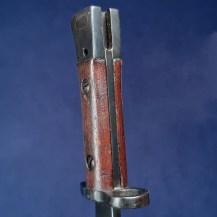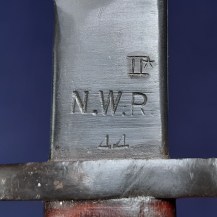Indian WW2 1907 Pattern Mk III Bayonet by North West Railways
Plain unfullered knife blade with clipped point and 2-inch false edge. Wood grips secured by two screws, squared pommel with oil hole. Black leather scabbard with iron throat and chape, khaki canvas frog.
The bayonet is stamped on one side at the ricasso with ‘II*’, the bayonet model, ’44’, meaning the bayonet was manufactured in 1944, and ‘N.W.R.’, meaning the manufacturer, the North West Railways workshop at Moghulpura, Lahore. This was a rolling-stock repair shop that was turned to producing bayonets during the war. It remains in operation to this day as part of Pakistan Railways. The throat of the scabbard is stamped with the serial number ‘13238’. The reverse of the frog is stencilled with ‘M.W.&S. Ltd 1941’, which stands for the manufacturer Michael Wright and Sons Ltd and a broad arrow War Department mark.
The Bengal & North Western Railway Company was founded in 1882 and ran the railway of the same name, carrying mail, freight and passengers northward from Delhi as far as Peshawar, until the 1st January 1943, when it was taken over by the Indian Government and merged with four other regional railways to form the Oudh & Tirhut Railway. During WW2 many of its metal workshops were converted to producing war materiel, and continued to do so even after hostilities ended.
Michael Wright and Sons, founded in 1860, was a major manufacturer of British webbing equipment in both World Wars and is still in business in Leicestershire today under the same family, still suppling the British Ministry of Defence.
You may notice that the model stamp is incorrect – this is certainly a MkIII due to its squared pommel, but the stamp shows ‘II*’. Incorrect factory stamping is a known phenomenon with Indian bayonets, as well as failing to add stamps for conversions, factory repairs etc. See British & Commonwealth Bayonets by Skennerton & Richardson, p348 and 351: they write that it is particularly common to see MkIIIs stamped as MkIIs.
These bayonets were made to fit the many SMLE No. 1 rifles made at Ishapore. Over time Indian bayonets became progressively simplified: the MkIII differed from the MkII in having a squared pommel and straight grips (without the curve to the belly of the grip found on other 1907 Patterns).
The blade, hilt and pommel retain their original blued finish. Some small dents and scratches to the wood grips. The locking button is fully functional. The scabbard leather is good with only small bumps and abrasions to its surface.










